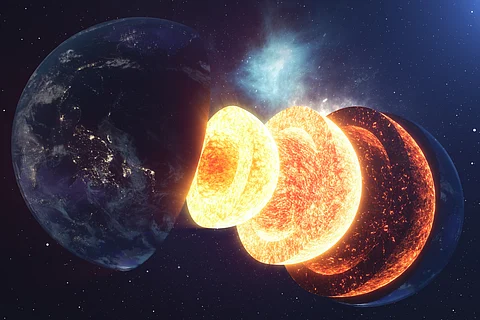

The Earth’s inner core is not as stable as once believed. A recent study has suggested it is undergoing structural changes, possibly affecting its rotation and even subtly altering the length of a day.
Interactions between the inner and outer core of the planet are the probable cause for the changes, said the study published in the journal Nature Geoscience. These findings challenge previous assumptions that changes in the inner core occur only over geological timescales.
Visualising Earth’s internal structure helps understand the importance of the discovery. Beneath the crust where life thrives, the planet has layers: First, the mantle, then the molten, iron-rich outer core, and at the centre, the solid inner core. While the outer core has long been known to be turbulent, its ability to influence the inner core on human timescales has remained uncertain.
“The molten outer core is widely known to be turbulent, but its turbulence had not been observed to disrupt its neighbour the inner core on a human timescale,” John Vidale, dean’s professor of earth sciences at the USC Dornsife College of Letters, Arts and Sciences and principal investigator of the study, said in a statement.
“What we are observing in this study for the first time is likely the outer core disturbing the inner core,” he added.
The researchers had set out to investigate a puzzling observation: Recent research had indicated that the inner core’s independent spin appears to be slowing. Scientists previously believed that the inner core rotated independently due to interactions with the mantle, but the latest data suggested a more complex interplay at work.
“What we ended up discovering is evidence that the near surface of Earth’s inner core undergoes structural change,” Vidale said.
Researchers examined seismic waves — shockwaves triggered by earthquakes — which travel through the Earth’s internal layers before returning to the surface.
Similar to how CT scans allow doctors to see inside the human body, seismic waves provide a glimpse into Earth’s hidden depths, Junlin Hua, with the University of Texas, previously told Down To Earth.
These waves travel from the earthquake source through the Earth’s internal layers and return to the surface. This is then picked up by sensitive instruments called seismometers, which produce an output called a seismogram that resembles an electroencephalogram, which measures the electrical activity of your brain.
The team scrutinised data from 121 repeating earthquakes recorded between 1991 and 2024 near Antarctica’s South Sandwich Islands. These quakes, occurring in the same locations over time, provided a rare opportunity to detect subtle changes in seismic wave behaviour.
One dataset presented an anomaly: Seismic waveforms displayed unexpected properties. On digging deeper, the team uncovered evidence of an additional physical process occurring within the inner core.
The physical activity could be due to structural changes in the inner core, the researchers hypothesised. This could be the result of viscous deformation — a phenomenon where materials flow in response to stress, similar to how honey or magma moves. Viscous flow describes the way liquids and even some solid materials deform under pressure, Magali Billen from the University of California, Davis, wrote in education resource platform Libretexts.
The study ultimately suggested that the near surface of the inner core is not as rigid as previously assumed. Instead, it appears to be experiencing structural changes due to its dynamic relationship with the turbulent outer core.